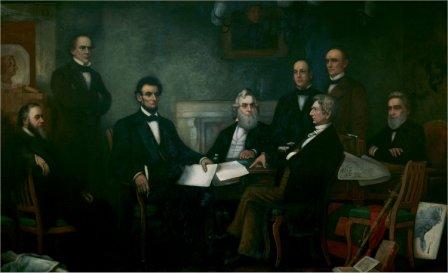Booker T.
Washington: Up From Slavery
Booker T. Washington was born into slavery in 1856. He dedicated himself
to education and started many schools for black students. He founded and was
named head of the Tuskegee Institute, a black university in Alabama. Washington
was a leader of the African American community until his death in 1915. Below
is a passage from Chapter 2 of his 1901 autobiography, Up From Slavery.
Washington speaks about going to school after he and his family are free.
My second difficulty was with regard to my name, or rather A
name. From the time when I could remember anything, I had been called simply
“Booker.” Before going to school it had never occurred to me that it was
needful or appropriate to have an additional name. When I heard the school roll
called, I noticed that all of the children had at least two names, and some of
them indulged in what seemed to me the extravagance of having three. I was in
deep perplexity, because I knew that the teacher would demand of me at least
two names, and I had only one. By the time the occasion came for the enrolling
of my name, an idea occurred to me which I thought would make me equal to the
situation; and so, when the teacher asked me what my full name was, I calmly
told him “Booker Washington,” as if I had been called by that name all my life;
and by that name I have since been known. Later in my life I found that my
mother had given me the name of “Booker Taliaferro” soon after I was born, but
in some way that part of my name seemed to disappear and for a long while was
forgotten, but as soon as I found out about it I revived it, and made my full
name “Booker Taliaferro Washington.” I think there are not many men in our
country who have had the privilege of naming themselves in the way that I have.
More than once I have tried to picture myself in the position of a boy or man
with an honored and distinguished ancestry which I could trace back through a
period of hundreds of years, and who had not only inherited a name, but fortune
and a proud family homestead; and yet I have sometimes had the feeling that if
I had inherited these, and had been a member of a more popular race, I should
have been inclined to yield to the temptation of depending upon my ancestry and
my color to do that for me which I should do for myself. Years ago I resolved
that because I had no ancestry myself I would leave a record of which my
children would be proud, and which might encourage them to still higher effort.
1. What is the best meaning for the word
"appropriate" as it is used in the passage?
A. proper
B. seize
C. plagiarize
D. unacceptable
2.The author's purpose for including the
statement, “yet I have sometimes had the feeling that if
I had inherited these, and had been a member of a more popular race,
I should have been inclined to yield to the temptation of
depending upon my ancestry and my color to do that for me which I
should do for myself, " was-
A. to make people feel bad.
B. to let readers know that he would rather
work hard to achieve his goals than depend on his ancestry.
C. to imply that the "more popular
race" was lazy.
D. to imply that the less popular race was
lazy.
3. Which of the following is NOT a cause for
Booker to add "Washington" to his name?
A. He realized that the other students had two names.
B. The teacher began to call the roll.
C. He didn't know that he already had a last name.
D. He didn't like his last name.
4. Which 2 of the following traits does NOT
describe Booker?
A. uneducated
B. lazy
C. intelligent
D. fortunate
5. From which point of view is the story written?
A. Third person, limited to the speaker.
B. First person
C. Third person omniscient
D. Second person
